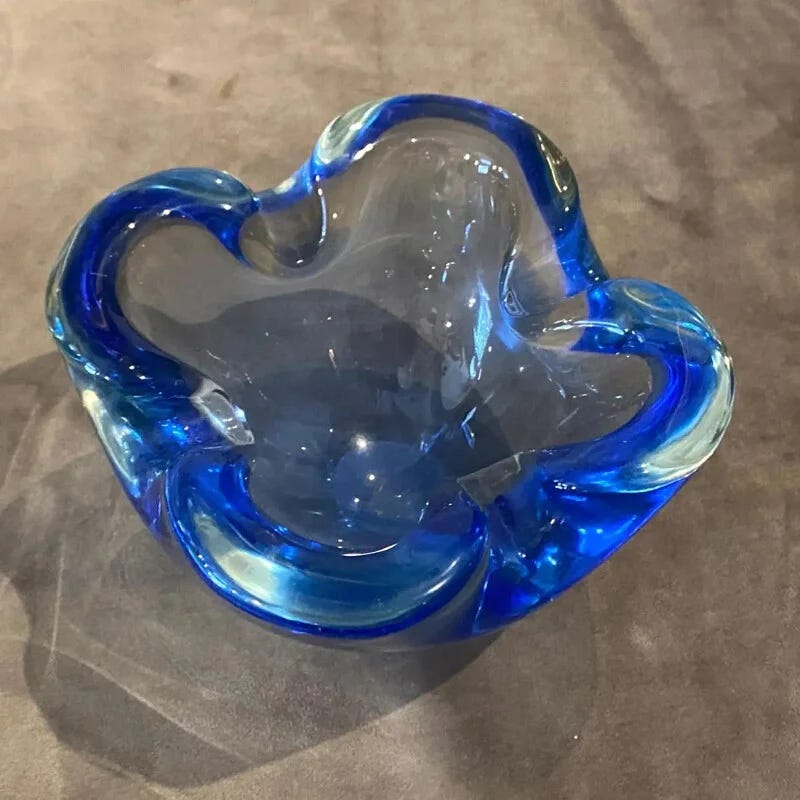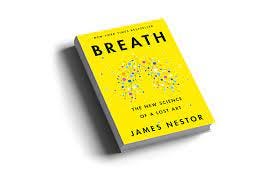When I was growing up ashtrays were a regular accouterment to any living room. We had two that I remember distinctly: a circular white one with bright orange in the middle, it’s edge marked by three turrets for holding Benson Hedges. And a heavy blue blown-glass number that I just found on ebay for $65. Up until the health conscious, “Let’s Get Physical” wave hit my house, we lived with a perpetual layer of ceiling smoke. All restaurants and movie theaters were hazy. My dad smelled like Lucky’s and Budweiser, a scent that I associated with a kind of sturdiness. My first fifteen years, I breathed smoke regularly. And, though I’m sure my mom destroyed the photo, I remember seeing one of her pregnant with me with an ashtray atop her stomach and a cigarette between her fingers.
Long before Christopher Columbus’ invasion, many Native American tribes smoked tobacco in pipes to mark ceremonial events. I witnessed this practice as a child in my school’s gymnasium when the Hupa Indians visited to share their dances and ceremonies with us. Then again, a few years ago at a temazcal (sweat lodge) ceremony ran by a group of indigenous women here in Costa Rica, the temazcalero chanted prayers for our health and smoked a pipe.
I thought about the gulf I felt between the sacredness of her intention and the ashtrays full of buds I had to dump out in the kitchen garbage as a kid. And while the surface intention (ceremony vs numbing) is obvious, it made me think my parents, my high school friends who would pass joints around as they sat in a circle holding their breath, or even colleagues who would stand in the rain together huddled in the smoking section, offering lighters—maybe all had something in common—sharing the intimacy of breath.
While I’m deeply grateful that I never became a smoker and American spaces are mostly smoke free, I’ve been thinking a lot about breathing and the connection that smokers found, and what they were doing with their breath, even if misguided. As I was writing this, I remembered maybe 15+ years ago smoking a cigar (of all things) while drinking a whiskey with a colleague Jim at a frozen midwestern work conference. We had trudged 30 minutes in a snowstorm and happened upon a cigar/whiskey bar. The warmth and unsustainability of that combo were clear.
In his insightful and entertaining book Breath, James Nestor takes readers on a personal and scientific adventure of breathing. Nestor explores how humans have lost the ability to breathe correctly, the health issues that ensue, and some amazing remedies—a few of which I’ve been tracking for myself. After reading the book, it became very clear that I, like most modern humans, have been breathing wrong: lots of shallow mouth breathing, breathholding while distracted, and breathing too much. If in doublt, Google, “email apnea,” and see if it resonates.
Listen. Are you breathing just a little and calling it a life? – Mary Oliver
My breathing has improved in Costa Rica with the moist, humid air, lack of air conditioning, but mostly from practicing daily conscious breath. I’ve actually known for a long time that I didn’t know how to breathe well. When I started swimming laps regularly, I was reminded of this. Belly breathing was not something my body did naturally. I had to train my body to relax, hold my breath and let it out more slowly in order to maintain a pace in the pool. When I was chatting with a childhood friend recently, she said, “I realized when I’m stressed, I have always held my breath unconsciously.” And, I know some of my chronic fainting came from unnatural shallow breathing. My history and Nestor’s research have guided my interest in doing more with my breath.
Teach What You Love
Since I love to teach topics or practices with which I am entangled, I’m starting a six month breathwork facilitator training program through Pause. In the past few years I’ve had two significant experiences through conscious breathwork sessions as a participant that deeply shifted and released trauma within my body—a sense of calm and equanimity that I’ve never had before. And now that I’ve had conscious breathing as a daily practice, I’m feeling the results.
Offerings
Free Breathwork Sessions
As part of my training, I’m going to be offering 30 minute and one hour breathwork practicums for free as I learn to lead them online and in person. If you are interested in exploring breathwork, you can email or message me to ask questions or schedule a session.
Gateless Writing on Tuesday Evenings in August
This summer give your inner critic the night off! Four Tuesdays in August, we will gather in the evening to breathe, write, share and celebrate. Each session includes a short talk, meditation/breathwork guidance, 25 minutes of writing time and sharing. Limited to 8 participants. Each session is $30 or all four $100. (Tuesdays, August 8, 15, 22, 29, 2023 6pm PST) Sign Up
Women’s Wellness Retreat: Release + Receive
If you are going to be in the San Francisco Bay Area in October, you won’t want to miss this opportunity. On October 8, 2023 from 10am-4:30pm, I’m teaming up with some of my favorite women: Christine Falcon-Daigle, Holiday Johnson, and Janine Cook for a day of deep healing and care through movement, Gateless writing, mindfulness, and energy work. We welcome you to a serene waterfront home in Mill Valley, CA, where you will be nurtured by an opening circle, an hour of delicious yoga, a Gateless Writing session with supported energy work. And, a chef will be providing vibrant vegan juices, snacks and a full lunch. $250 (Limited to 10 participants.) Sign Up.







You are describing my childhood home, too, minus the burn marks on the edge of so many countertops and other surfaces. Thanks for sharing your healing journey and the humility with which you do so. Honored to be collaborating with you in October.